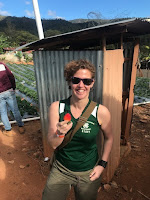Postharvest Loss to Postharvest Win: Guyana Farmer-to-Farmer

Mr. Rodriguez on-location in Guyana at CV Farms with Kinaka Craig & F Valentine Mauricio G. Rodriguez, a U.S.-based private consultant, recently volunteered in Guyana as a Farmer-to-Farmer (F2F) Volunteer with Partners of the Americas . His F2F assignment focused on assisting local small-scale produce farmers through postharvest management training. In Guyana, Mr. Rodriguez met with vegetable and herb producers who were experiencing significant crop and financial losses in postharvest transportation of their crops when shipping to Georgetown supermarkets. Noting the producers utilize hydroponic technology and organic soil mixes throughout the growth of the produce , he was then able to evaluate potential issues at the point of postharvest. After preliminary visits to different Georgetown supermarkets, he discovered the problem. From the point of harvest and to the supermarket , the crops were exposed to varying storage and outside temperatures. The produce
